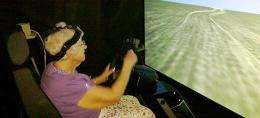Mid-lane driving helps older adults stay safe

(Medical Xpress) -- It's official: older adults are naturally inclined to drive in the middle of the road, leaving the younger generation to cut corners.
This tendency to sit mid-lane is an in-built safety mechanism that helps pensioners stay safe behind the wheel, according to researchers at the University of Leeds.
The findings of the study, which are published in the Journal of Experimental Psychology Human Perception and Performance, have shown how older people naturally adapt when they can no longer move with the freedom they once had. Researchers hope that the work will be used to find new ways of helping patients recover lost motor skills, for example, after a stroke.
Aging causes the body to respond more slowly and movements to become less precise. To see how this might affect performance behind the wheel, a team from the University of Leeds' Institute of Psychological Sciences compared the motor skills of healthy younger adults, aged between 18 and 40, with a group of over-60s.
Using a touch-screen laptop, participants were asked to trace wiggly lines of varying widths - slowly, quickly and at their own preferred pace. They were also asked to steer along 'virtual' winding roads when sitting in a driving simulator.
The researchers found that the older adults made allowances for their age by adopting a 'middle-of-the-road' strategy in both tests. This meant they remained well inside the wiggly lines when tracing, and stayed in the middle of the road lines when driving. Younger participants, in contrast, had a greater tendency to cut corners.
However, when study participants were asked to drive faster in the simulator and to follow narrower paths, all tended to cut corners more - regardless of their age.
"Our results suggest that this compensation strategy is a general phenomenon and not just tied to driving. It seems older people naturally adjust their movements to compensate for their reduced level of skill," said postgraduate researcher Rachel Raw, lead author of the study.
"But this compensation can only take you so far, and when conditions are difficult, perhaps because of snow or hail, or when driving at night time on poorly lit roads, older adults can struggle," she said.
"It is important to establish what strategies are adopted by older drivers in order to ensure their safety - as well as the safety of other road users." said psychology researcher Dr. Richard Wilkie, who supervised the work. "More generally, understanding how older people learn to adapt to a diminished level of skill has implications for our approach to rehabilitating patients with reduced movement, for instance, after a stroke."
More information: Raw RK et al, 'Movement control in older adults: does old age mean middle of the road?' Journal of Experimental Psychology Human Perception and Performance is published online in advance of publication [doi: 10.1037/a0026568].















